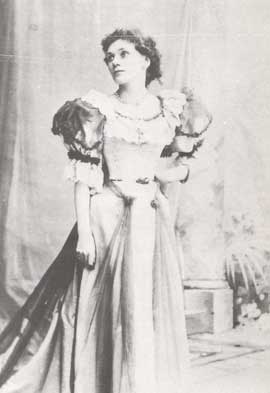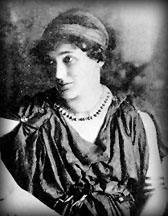Florence Farr facts for kids
Quick facts for kids
Florence Farr
|
|
|---|---|
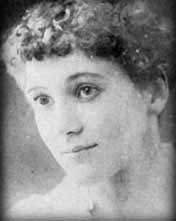 |
|
| Born |
Florence Beatrice Farr
7 July 1860 Bickley, Kent, UK
|
| Died | 29 April 1917 (aged 56) |
| Other names | Mary Lester |
Florence Beatrice Farr (born July 7, 1860 – died April 29, 1917) was a talented British actress, composer, and director. She was also a strong supporter of women's rights, a journalist, teacher, singer, and writer. Florence was even a leader in a special group called the Hermetic Order of the Golden Dawn, which studied magic and spiritual ideas.
She was friends and worked with many famous people of her time, like the writer William Butler Yeats and the playwright Oscar Wilde. Florence Farr was known for being very independent and ahead of her time. She was an early feminist, meaning she believed strongly in equal rights for women. She spoke out for women's right to vote, fair pay, and equal treatment under the law. She even wrote a book and many articles about the rights of "the new woman."
Early life
Florence Beatrice Farr was born in Bickley, Kent, England, in 1860. She was the youngest of eight children. Her father, Dr. William Farr, was a doctor and a friend of Florence Nightingale, who was famous for nursing. He named Florence after Nightingale. Dr. Farr believed in equal education and job opportunities for women, which likely influenced his daughters.

In 1873, Florence went to Cheltenham Ladies' College. One of her friends there was May Morris, whose mother was a famous artist's model. Through May, Florence met many artists and thinkers in London. When she was 19, Florence and her friends posed for a famous painting called "The Golden Stairs" by Sir Edward Burne-Jones. This painting is now in the Tate Gallery in London.
From 1877 to 1880, Florence attended Queen's College, which was the first college for women in England. After college, she worked as a teacher, but she soon wanted to become an actress.
Theatrical career
Florence Farr started acting in plays with an amateur group. In 1882, she began training professionally at Toole's Theatre. At first, she used the stage name Mary Lester because her father didn't want the family name connected to the theatre. Her first professional role was "Kate Renshaw" in a play called Uncle Dick’s Darling.
In 1883, her father passed away, leaving her some money. She continued acting and soon changed her stage name back to Florence Farr. People noticed her strong presence and beautiful voice. She became quite successful on London's stages. In 1884, she married another actor, Edward Emery. Their marriage was not happy, and she felt restricted by the rules for wives in the Victorian era. In 1888, her husband went to America, and they never saw each other again. She got a divorce in 1895 and never remarried.
Around 1890, Florence moved to Bedford Park, a lively area in London where many artists and writers lived. This place was known for its "free thinkers" and the "New Woman" idea, where women openly discussed politics, art, and philosophy with men. Florence was an early feminist who spoke up for women's equality in jobs and pay. She likely met William Butler Yeats here, as her brother-in-law was painting his portrait.
While in Bedford Park, Florence starred in a play called A Sicilian Idyll. George Bernard Shaw was in the audience and was very impressed by her acting and her "startling beauty." Shaw wanted her to be the star of his plays and represent his idea of "The New Woman."
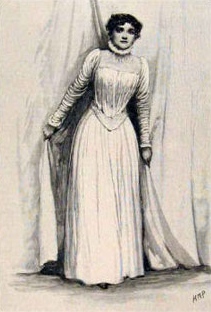
For Yeats, Florence was a special inspiration. He loved her voice, which he felt was perfect for reciting his poems. He wrote that he had "never heard verse better spoken." Both Shaw and Yeats wrote important parts in their plays specifically for Florence. She also used her influence to help get their plays produced.
Florence was also the first woman in England to act in plays by the famous writer Henrik Ibsen. She played Rebecca West in Rosmersholm in 1891, which earned her great praise. The character of Rebecca West was a "New Woman" who challenged old ideas, a role that fit Florence perfectly.
Producer and director
In 1893, Florence Farr started her own project as a director, putting on a series of plays at the Avenue Theatre. She asked her friend, artist Aubrey Beardsley, to design the poster. Florence had acted in Shaw's first play, Widowers' Houses, and she asked both Shaw and Yeats to write new plays for her theatre. Yeats provided a short play, The Land of Heart’s Desire. Shaw's play wasn't ready in time, so another play was used, but it wasn't very successful.
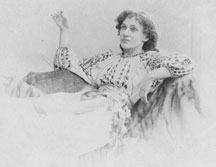
After Florence sent him an urgent message, Shaw quickly finished his play, Arms and the Man. With only one week to practice, Florence played the lively servant girl Louka. This play was a funny story that made fun of romantic ideas about war. It was a big hit with audiences and critics. However, Florence was becoming closer to Yeats and less so to Shaw, so Arms and the Man was the last play by Shaw she performed in.
Throughout the 1890s, Yeats used Florence's beautiful voice to help bring spoken poetry back to life. In 1898, in Yeats' play The Countess Cathleen, she played Aleel, a poet who could see into the spirit world. She sang all her lines while playing a psaltery, a type of harp. Florence often performed in Yeats' plays. In 1898, he made her the stage manager for his Irish Literary Theatre. However, during this time, Florence also became deeply involved with a secret group called The Hermetic Order of the Golden Dawn, which took her away from her theatre career.
Golden Dawn
The Golden Dawn was a secret society, similar to Freemasonry, but it allowed women to join and have equal roles with men. Florence Farr joined the Golden Dawn in London in July 1890, with the help of Yeats. She took a special magical name, Sapientia Sapienti Dona Data, which means "Wisdom is a gift given to the wise."
Florence became a leader in the group in 1894. She was in charge of teaching and gave classes on things like tarot card reading, scrying (looking into a crystal ball or mirror to see visions), and Enochian magic. While many people in the late 1800s were interested in Spiritualism and Theosophy (spiritual philosophies), Florence actually practiced magic, including calling upon spirits.
She wrote her first philosophical paper about the group's ideas in 1894 and also wrote some of the Golden Dawn's secret teaching papers. When one of the group's founders left in 1897, Florence took his place as the "Chief Adept in Anglia." This made her the leader of the English branches of the Golden Dawn and the official representative for the main founder, who lived in Paris.
By 1899, some disagreements arose within the Golden Dawn. There were also members who didn't like having a woman as the Chief Adept. Florence eventually felt the group should close. She resigned from her leadership role in January 1900. After some internal conflicts and investigations, the main founder was expelled in 1901. Florence, Yeats, and others tried to reorganize the group, but it was difficult. Florence remained in her leadership position for a while but resigned in January 1902 after some public issues made the once-secret society seem silly.
Later life
After leaving the Golden Dawn, Florence Farr joined the Theosophical Society of London, another spiritual group. She then wrote and produced two plays with Egyptian themes. Florence also worked on many plays for different theatres in London between 1902 and 1906, helping with acting, directing, and music. She often performed Yeats' poetry, setting it to music she played on her psaltery. Florence toured in Great Britain, Europe, and America in 1906 and 1907 to share the "new art" of Irish literary theatre. In America, she met and worked with Pamela Colman Smith, who later became famous for her Tarot card art.
During this time, Florence also wrote articles regularly, especially about women's rights, theatre, and ancient Egyptian religion. She wrote for the British journal The New Age and for Theosophical journals. In one essay, she wrote that simply changing laws wasn't enough to free women. She believed women needed to change themselves first, to believe they could achieve anything they wanted.
In 1906, Florence lectured at the Leeds Arts Club with Yeats about how to speak poetry while playing a psaltery. In 1908, she spoke about theatre, its history, and read poems by Yeats and Homer, again with her psaltery.
Through the Theosophical Society, she met Ponnambalam Ramanathan, a spiritual teacher from Ceylon (now Sri Lanka). Florence was very impressed by his plans to educate young women in his home country.
In 1912, Florence learned that Ramanathan had opened his Uduvil Ramanathan Girls College. At 52 years old, she sold everything she owned and moved to Ceylon to become a teacher again. Florence was appointed Lady Principal of the school. Her organizational skills from leading the Golden Dawn helped her greatly. The school did very well under her leadership because she respected the local Tamil traditions. Florence also continued to write to Yeats, sending him her translations of Tamil poetry.
In 1916, Florence was diagnosed with cancer. She had surgery, but the cancer had spread. Florence Farr died a few months later in April 1917, at the age of 56, in a hospital in Colombo. As she wished, her body was cremated, and her ashes were scattered in the sacred Kalyaani River by Ramanathan.
In his poem "All Souls' Night," Yeats remembered her:
On Florence Emery I call the next,
Who finding the first wrinkles on a face
Admired and beautiful,
And by the foreknowledge of the future vexed;
Diminished beauty, multiplied commonplace;
Preferred to teach a school
Away from neighbor or friend,
Among dark skins, permit foul years to wear
Hidden from eyesight to the unnoticed end.
Works
- Florence Farr (2022) The Egyptian Rituals Holythorn Press ISBN 9781838445317


